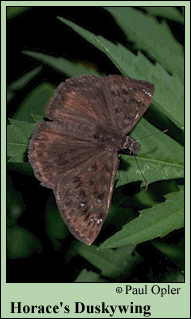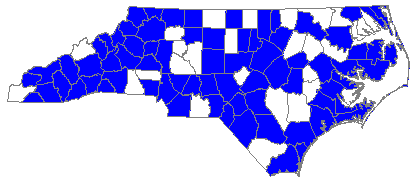 |
 

 |



Horace's Duskywing (Erynnis horatius [Scudder & Burgess])
Wing span: 1 7/16 - 1 15/16 inches (3.6 - 4.9 cm).
Identification: Fringes are brown. Upperside of male forewing is dark brown with little contrast and no white overscaling. Upperside of female forewing is light brown with a contrasting pattern and large transparent spots. Underside of hindwing is usually without 2 spots below the apex. Male has a costal fold containing yellow scent scales; female has a patch of scent scales on the 7th abdominal segment.
Life history: To seek females, males perch at the ends of twigs on hilltops or slopes about 1 foot above the ground. Mating has been observed around midday; females deposit eggs singly on new growth of the host. Caterpillars feed on young leaves and rest in leaf nests. Caterpillars of the last brood hibernate.
Flight: Two broods in the north from April-September, three broods in the Deep South and Texas from January-November.
Caterpillar hosts: Both red and white oaks including willow oak (Quercus phellos), northern red oak (Q. velutina), scrub oak (Q. ilicifolia), water oak (Q. nigra), post oak (Q. stellata), and live oak (Q. virginiana).
Adult food: Horace's Duskywing visits flower up to about 4.5 feet tall including dogbane, buttonbush, sneezeweed, goldenrod, peppermint, boneset, and winter cress.
Habitat: Open woodlands and edges, clearings, fencerows, wooded swamps, power-line right-of-ways, open fields, roadsides.
Range: Massachusetts west to eastern South Dakota; south through most of the eastern United States to Florida, the Gulf Coast, and South Texas; south in the west through southeastern Utah, Colorado, northeastern Arizona, and New Mexico.
Conservation: Not usually required.
The Nature Conservancy Global Rank: G5 - Demonstrably secure globally, though it may be quite rare in parts of its range, especially at the periphery.
Management needs: None reported.
References:
Opler, P. A. and G. O. Krizek. 1984. Butterflies east of the Great Plains. Johns
Hopkins University Press, Baltimore. 294 pages, 54 color plates.
Opler, P. A. and V. Malikul. 1992. A field guide to eastern butterflies. Peterson
field guide #4. Houghton-Mifflin Co., Boston. 396 pages, 48 color plates.
Scott, J. A. 1986. The butterflies of North America. Stanford University Press,
Stanford, Calif. 583 pages, 64 color plates.
Stanford, R. E. and P. A. Opler. 1993. Atlas of western USA butterflies including
adjacent parts of Canada and Mexico. Denver and Fort Collins, CO.
Tilden, J. W. 1986. A field guide to western butterflies. Houghton-Mifflin Co.,
Boston, Mass. 370 pages, 23 color plates.
Author: Jane M. Struttmann
State and Regional References:
Layberry, R.A., Hall, P.W. & Lafontaine, D.J., 1998. The Butterflies of
Canada. University of Toronto Press, Toronto, ON. 280 pp.
Opler, P.A. 1998. A field guide to eastern butterflies, revised format.
Houghton Mifflin Co., Boston.

